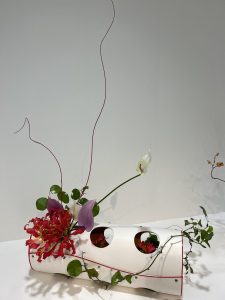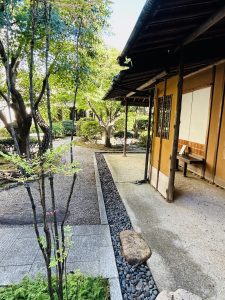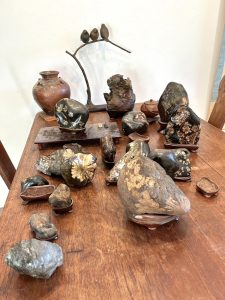花にご縁のある週でした(愛知県名古屋市千種区姫池通 骨董買取 古美術風光舎)
2023.09.16
皆さまこんにちは。スタッフHです。
例年ですと9月の3連休は秋の風を感じ始め、絶好の行楽日和だと思うのですが、今年は事情が違うようです。皆さまくれぐれも体調に気をつけてお過ごしください。
今週はお花に縁のある週になりました。
一つはチケットを頂き、生け花の展覧会に行く機会があったこと。そしてもう一つはお祝い事があり、久しぶりに花束を贈ったことです。お花は見ているだけで気分が華やぎます。
生け花の展覧会。伝統的なものから斬新なものまで多種多様で、楽しませていただきました。花器との一体感が印象的です。




花束の方は近所で気になるお花屋さんがあったので前日に相談に行き、花を選んでいただきました。オレンジの花はなんと向日葵(ひまわり)だそうです。向日葵は現在100種類以上あるとか。当日引き取りに行くと、とても素敵な花束が用意されていました。

細長く伸びているのは「トラノオ」という花で、当日に追加されていました。花言葉は(永久)や(不滅)で、結婚や長寿のお祝いとして人気だそうです。
以前フラワーアレンジメントの体験レッスンを受けた時、どの角度から見ても美しく、そして隙間なく埋めていくよう教えていただきました。それが案外難しかったのを覚えています。
その頃生け花を少しかじっていたので混乱したのかもしれません。華道では「正面を意識して少ない花材で、そこに新しい空間を作るように」と指導されます。
どちらのお花も好きなのですが、何が違うのだろうとふと考えました。
私の個人的なイメージですが…。西洋のアレンジメントは、生ける時に花自体に意識が向き、花がいかに美しく綺麗に見えるかに集中している気がします。花の表情を見ながら次々と足していく感じでしょうか。
華道では花というより生けている自分と花器の周りの小さな空間に意識が向いている気がします。そして少ない花材を1本1本ゆっくり時間をかけて生けていきます。先生が手直してをしてくださる時、たった1本をほんの少し向きを変えたり移動させたりだけで、空間が激変しました。先生の手から何か出ているのではと思うほど空気の流れが変わるのです。
フラワーアティストの假屋崎省吾さんのお花はこの2種類の花の世界が絶妙にミックスされていると勝手に思っています。
以前スタッフYもブログでつぶやいておりましたが、残念ながら花は人間を喜ばせるために美しく咲いているのではなく、花を色づかせて虫を呼び寄せ、種を存続させるために色とりどりに進化してきました。
こちらがどんなに見つめても我関せずといったつれない雰囲気に勝手に癒され、励まされ幸せな気分になります。
本当は言葉が少ない方が人の心に届くのかもしれませんね。

それでは、またお会いしましょう。
Hello everyone. This is Staff H.
Usually, we start to feel the autumn winds during the three-day weekend in September, which I think is the perfect day for an excursion, but this year seems to be different. Please take care of your health.
This week has been a week of flowers.
One is that I received a ticket and had a chance to visit an ikebana exhibition. The other is that I had a celebration and sent a bouquet of flowers for the first time in a long time. Just looking at flowers makes me feel happy.
An exhibition of ikebana. I was entertained by a wide variety of traditional and innovative flower arrangements. The sense of unity with the vase is impressive.
For the bouquet, there was a florist in the neighborhood that I was interested in, so I went to consult with him the day before and he selected the flowers for me. The orange flowers were sunflowers. There are currently more than 100 varieties of sunflowers. When I went to pick up the flowers on the day of the event, a very nice bouquet was prepared.
The long and slender “Toranowo” flowers were added on the same day. The language of flowers is (everlasting) and (immortal), and they are popular as congratulations for marriage and longevity.
When I took a trial flower arrangement lesson before, I was taught to make sure that the flower arrangement was beautiful from all angles and filled in without gaps. I remember it was surprisingly difficult.
Perhaps I was confused because I had dabbled a little in ikebana at the time. In flower arrangement, we are taught to be conscious of the front and to create a new space there with fewer flowers.
I like both types of flowers, but I suddenly wondered what the difference was.
This is my personal image…. I feel that in Western arrangements, the focus is on the flowers themselves when arranging them, concentrating on how beautiful and lovely they look. I guess it is like adding one flower after another while looking at the expression of the flower.
In flower arrangement, I feel that I am more conscious of myself and the small space around the vase than of the flowers. I take my time to bring each flower to life, one by one, with the few materials I have. When the teacher was rearranging the flowers, the space changed drastically with just a slight change in the direction or movement of just one flower. The air flow changed so much that I thought something was coming out of her hands.
I think Shogo KARIYAZAKI’s flowers with Flower Attis are an exquisite mix of these two flower worlds.
As Staff Y once tweeted on his blog, unfortunately, flowers do not bloom beautifully to please humans, but have evolved in a variety of colors to attract insects and keep the seeds alive by making the flowers colorful.
No matter how much I stare at them, I am healed, encouraged, and happy by their unassuming atmosphere.
In truth, perhaps it is the few words that reach people’s hearts.
I hope to see you again.
*******************
ご実家の整理やお片付けなどをされている方のご相談などが多くございます。
お片付けなどくれぐれもご無理のないようになさってくださいませ。
風光舎では古美術品や骨董品の他にも絵画や宝石、趣味のお品など様々なジャンルのものを買受しております。
お片付けをされていて、こういうものでもいいのかしらと迷われているものでも、どうぞお気軽にご相談下さいませ。
また風光舎は、出張買取も強化しております。ご近所はもちろん、愛知県内、岐阜県、三重県その他の県へも出張いたします。
まずは、お電話お待ちしております。
愛知県名古屋市千種区姫池通
骨董 買取【古美術 風光舎 名古屋店】
TEL052(734)8444
10:00-17:00 OPEN
#出張買取#骨董#古美術#骨董品#絵画#版画#茶道具#刀剣#彫刻

























